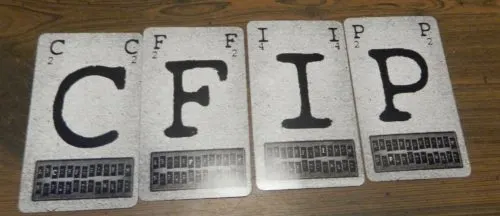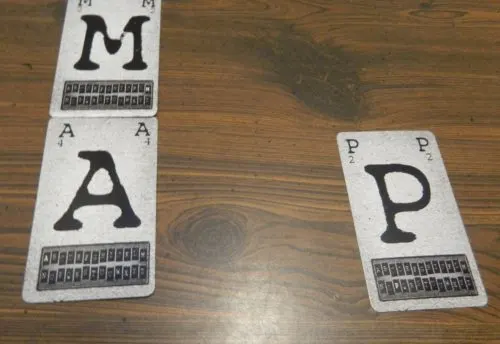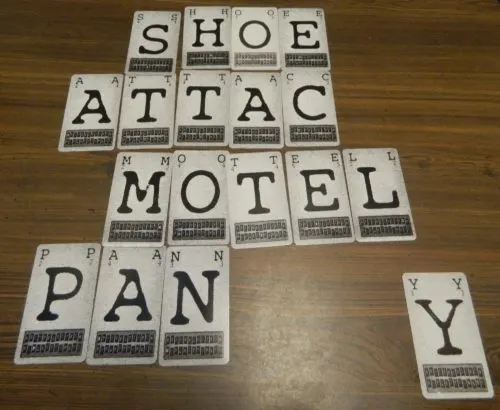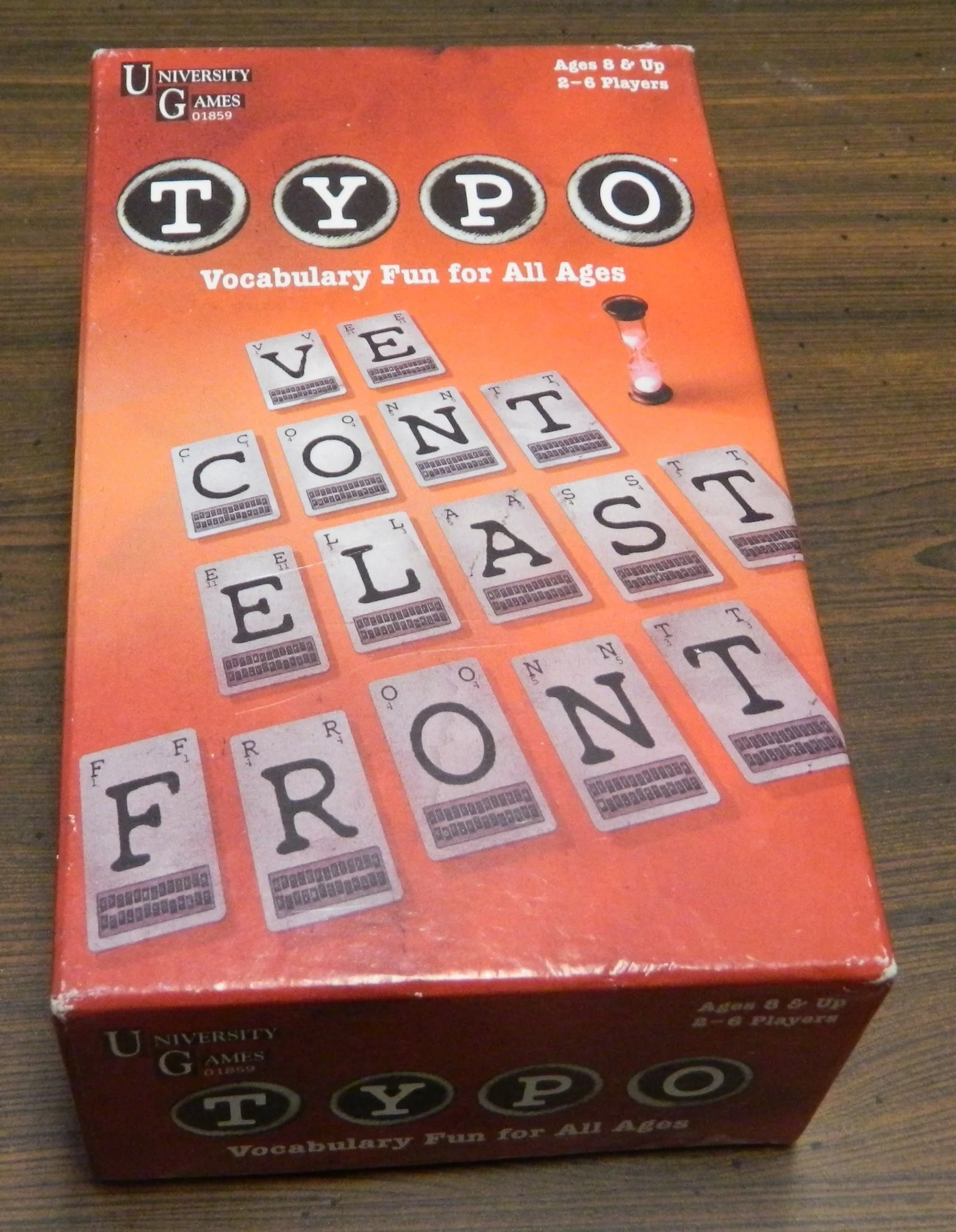I have played a lot of different word games in the past. While not a huge fan of the word game genre, I occasionally like playing word games and am always looking for a word game that tries to do something new with the genre. I was hoping that game was going to be Typo since it actually blends a word game with a mechanic that I never thought I would see in a word game. While it has its’ own flaws, Typo does some interesting things with the word game genre to create a unique word game experience.
How to Play Typo
Setup
Shuffle all of the cards and randomly place four of the cards face up on the table.
Deal out the following number of cards to each player depending on the total number of players:
- 2 players: 14 cards
- 3 players: 13 cards
- 4 players: 12 cards
- 5 players: 11 cards
- 6 players: 10 cards
Determine the first player in any way you deem appropriate.
Playing Cards
To begin each turn every player chooses one of their cards that they are going to play in the next round. Once every player has played their chosen card face down on the table, everyone reveals the card that they played. The player who played the letter that comes first in the alphabet will get to play their card first. The player who played the second earliest letter gets to play second and so on. If two players ever play the same letter, the player who currently has the timer or the player who is closest clockwise to the player with the timer gets to play their card first.

These four cards were played for the current round. Since C comes first in the alphabet, the player who played this card will get to play it first. The player who played the F will play next followed by the I and the P.
When it is a player’s turn to play their card they need to add it to one of the four rows of cards laid out on the table. Players can either add it to the beginning of the row or at the end of the row. After placing the card the player has to say a word that starts with the letters (in the same order) of the row that they added their card to.

The current player played a P. They can play it before the A and say a word like paint. They could also play it after the A and say apple.
Each player has 30 seconds to place their card and say an appropriate word or they will have to draw cards from the table (see Drawing Cards section).
Each player plays their card in turn and when everyone has played their card a new round begins with players choosing a new card to play.
Drawing Cards
If a player is unable to come up with a word where they can add their card to one of the rows, the player will have to draw cards from the table. If the player comes up with a word and a majority of the players don’t believe the word is actually a word or is an illegal word (proper names, geographical locations, abbreviations) they can challenge the word. Players can look up the word in a dictionary to see if it is actually a word. If the word is actually a legal word, the player who came up the word will get to randomly get rid of one of the cards from their hand (removed from the game). If the word doesn’t exist the player will draw cards (see below) and will have to take one additional card for using an illegal word.
When a player has to draw cards they will take cards from the row with the most cards in it. If there are multiple rows with the same number of cards, the player can choose which row to take cards from. The player takes half of the cards from the row (starting with the cards at the end of the row) and adds them to their hand. If there is an odd number of cards in the row, the player takes the extra card. The first half of the row is removed from the game and the card that couldn’t be played or was improperly played starts a new row. A player who drew cards gets to immediately take the timer.

The current player played a Y and can’t think of a word they can create with the Y and the letters already on the table. The player can either take cards from the second or third row since they both have five cards. The player will have to take the last three cards in the row and the first two cards are discarded. The Y card will start the new row.
Winning the Game
The first player to get rid of all of their cards wins the game.
My Thoughts on Typo
At its’ core Typo is very similar to your basic word game. Players are dealt letter cards and they need to use those cards to form words. I have probably played at least 10 different word games that have used a very similar premise. The word game genre is not what I would call a wildly original genre of games. There just is not a whole lot you can do to change a spelling/word game outside of tweaking how you use the letters that you are given. This is the one area where Typo tries to stand out and ends up being the game’s greatest strength.
What I found interesting about Typo is that it feels like a word game that was merged with a game like Slide 5/6 Nimmt. This is an interesting combination of mechanics and something I didn’t think I would see in a word game. While Slide 5 is a better game in my opinion, the mechanic for playing cards is a welcome addition to Typo. Typo pretty much plays just like Slide 5 except that the numbers have been replaced with letters and you now need to worry about spelling/vocabulary.
This mechanic makes Typo interesting since there is actually some strategy in choosing which card you want to play at a given time. The earlier a card is situated in the alphabet, the earlier it gets to be played. While it is best to play earlier in the round, you likely won’t only get early cards. This forces players to figure out the best time to play their earlier and later cards so they are still able to play them to one of the rows. While I think there is more strategy in Slide 5 (since you don’t have to worry about spelling), Typo has more strategy than most word games. Once everyone has revealed their cards it is usually pretty easy to tell where the other players want to play their card. This gives players an incentive to try and mess with the other players in order to force them to draw cards.
Like most card and word games there is quite a bit of luck involved in Typo. While players with strong vocabularies have a distinct advantage in the game, luck plays a big role as well. You may be able to come up with a lot of words that can be formed with the letters already out on the table but if you don’t have the right cards there isn’t a lot that you can do. If you end up with a lot of cards that are rarely used you are going to have a hard time winning the game no matter how strong your vocabulary skills are.
Card distribution actually leads to a situation where the end game comes down to who was dealt the best cards. Pretty much every player will be forced to draw cards at some point in the game unless they get extremely lucky and the cards just go their way. Since every player will probably have to draw cards at least once during the game, this creates a situation where all of the players will be quite close at the end of the game. The winner then comes down to who has the best cards remaining and who has a little luck based on what the other players do.
As a whole Typo just seems to take too long. Typo feels like a 10-15 minute game and ends up being more of a 20-30 minute game. With players having to draw additional cards several times in the game, it makes the game drag on for too long. I personally would have preferred the game if it was shorter since you could then play a couple rounds in the time it takes to play one round which would allow a player who had bad luck in one round to possibly have better luck in another round. As it stands though a player could be stuck in a 20-30 minute game that they likely won’t win based on the cards that were dealt to them.
While I liked the idea of the cards being played in order based on a set condition, I think the methodology of starting at the beginning of the alphabet is a mistake. The reason I think this is flawed is that it contributes to the reliance on drawing good cards. I personally don’t think it is really fair that some of the letters used in the most words are also some of the letters that are played first since they are early in the alphabet. This rule makes X,Y, and Z the three worst cards in the game since it is hard to find situations where you can actually use them and since they are the last cards that will be played in a round, the one opportunity to play them will likely be gone before the player is actually able to play them.
This is why I would propose using a house rule where the cards get played based on how prevalent they are in the deck of cards. For example the letters that only appear once in the deck will get played first and so on. Since all of the cards already have their frequency printed on them, this house rule would be easy to implement. The reason I think this would significantly improve the game is that it would balance out some of the luck involved with drawing bad cards. You might get a card that is hard to play but you would also be able to play it early so you would have a better chance of no players messing with the word you were going to form. Also if you get a lot of good cards you will have to wait longer to play which will make you have to be more adaptable as other players mess with the words you wanted to make.
As far as components there is nothing special about Typo. There are just cards and a timer. The cards are nothing special since they are pretty thin and the artwork is quite bland. You can’t really expect much from the cards for a word game though since basically all you need are letters that are easy to read. Typo succeeds at creating easy to read cards.
Should You Buy Typo?
I think the best way to describe Typo is to say that it is a very average card game. There is nothing really wrong with the game but there also isn’t anything great either. In general I liked the mechanic where cards are played based on where they are located in the alphabet since it adds strategy and players need to figure out the best times to play their cards. I wish the order that cards are played in would change though since it favors players who draw good cards. Otherwise Typo relies a little too much on luck and doesn’t differ drastically from other word games.
If you aren’t a huge fan of word games you should probably pass on Typo since while it is solid it is not going to change anyone’s opinion on word games. The unique mechanics in the game are also done better in other games like Slide 5 so I would probably recommend picking up those games instead. If you like word games and the unique mechanic added in Typo though, I think you could really enjoy Typo.
If you would like to purchase Typo you can find it online: Amazon, eBay


